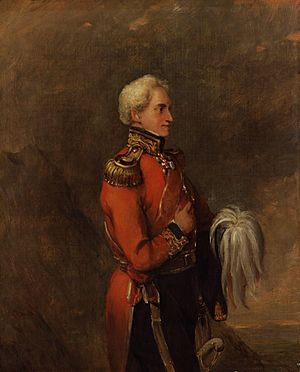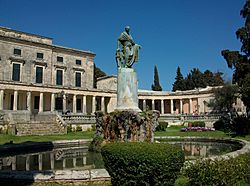Frederick Adam facts for kids
Quick facts for kids
General
Sir Frederick Adam
|
|
|---|---|

Frederick Adam as painted by William Salter, 1848 or after
|
|
| Born | 17 June 1781 Scotland |
| Died | 17 August 1853 (aged 72) |
| Allegiance | |
| Service/ |
|
| Years of service | 1795-? |
| Rank | General |
| Commands held | 3rd (Light) Brigade |
| Battles/wars | Peninsular War: Battles of Castalla, Alicante, Biar, Ordal War of the Seventh Coalition: Waterloo |
| Awards | Knight Grand Cross of the Order of the Bath |
| Relations | father: William Adam (MP) |
| Other work | Lord High Commissioner, Ionian Islands Governor of Madras |
Sir Frederick Adam (born June 17, 1781 – died August 17, 1853) was a brave Scottish general. He is famous for his role as a major-general at the Battle of Waterloo, where he led the 3rd (Light) Brigade. After his military career, he became a very important leader in the Ionian Islands. He even helped build famous places like Mon Repos, Corfu there.
Contents
A Young Soldier's Start
Frederick Adam was born in Scotland at Blairadam House. When he was just 14 years old in 1795, he joined the British Army. He trained at the special artillery school in Woolwich. Soon after, he became a first lieutenant. By 1796, he was promoted to second lieutenant.
He fought in important campaigns in the Netherlands and Egypt. He served under a famous general named Sir Ralph Abercromby. Frederick Adam quickly moved up the ranks. He became a major in 1803 and a lieutenant colonel in 1804.
Fighting in the Peninsular War
From 1806 to 1811, Frederick Adam was stationed on the island of Sicily. Later, between 1812 and 1813, he fought in Spain during the Peninsular War. This was a big war where Britain fought against France.
During this war, he was badly hurt in a battle near Alicante. On April 12, 1813, he led a brave action to protect his army's retreat. This happened against the French army led by Marshal Louis-Gabriel Suchet at Biar. The very next day, his soldiers caused many losses to the French during the Battle of Castalla. He was wounded again in another fight at Battle of Ordal on September 13, 1813.
The Battle of Waterloo
On June 18, 1815, Frederick Adam played a key role in the famous Battle of Waterloo. He commanded the 3rd British Brigade. This battle was a huge fight against the French army led by Napoleon.
At a very important moment in the battle, Adam's soldiers from the 52nd (Light) Foot made a clever move. They turned to the side and fired at the French Imperial Guard. The French Imperial Guard was Napoleon's best fighting force. They were already being attacked from the front by other British soldiers.
Under fire from two directions, the French soldiers fought briefly, then ran away. After their attack failed, the French Guard tried to regroup. They gathered near La Haye Sainte for one last stand. But Adam's brigade charged them again. This caused even more confusion, and the remaining French soldiers retreated. It was during this time that a French general named Pierre Cambronne surrendered.
The French Imperial Guard made a final stand in square formations. These were on either side of a place called La Belle Alliance. General Adam's Brigade bravely charged one of these squares. It was on a small hill to the right of La Belle Alliance. His charge broke their formation and caused them to scatter. The other French square was attacked by the Prussian army. The French army then retreated completely from the battlefield. The British and Prussian armies captured all of their cannons and supplies.
| Unit | Commander | Strength | Casualties |
| 3rd (Light) British Brigade | Major General Frederick Adam | 2,937 men | 698 |
| 1/52nd Regiment of Foot (Oxfordshire Light Infantry) | Lt-Colonel Sir John Colborne | 1,130 | 199 |
| 1/71st Regiment of Foot (Highland Light Infantry) | Lt-Colonel Reyner | 936 | 202 |
| 2/95th Regiment of Foot (Rifles) | Major Norcott | 666 | 247 |
| 3/95th Regiment of Foot (Rifles) | Major John Ross | 205 | 50 |
Life After the Military

After the Battle of Waterloo, Frederick Adam continued his army career until 1824. From 1824 to 1832, he held a very important job. He was the Lord High Commissioner of the Ionian Islands. This meant he was the main leader for these islands, which were under British protection.
The people of the islands really liked him. He ordered the building of many public buildings on the island of Corfu. One famous building he helped create was Mon Repos, Corfu.
Later, from 1832 to 1837, he served as the Governor of Madras. Madras was an important part of British India at the time. In 1846, he was promoted to the highest rank of general.
Important Military Commands
Here are some of the important military commands Frederick Adam held:
- 1813 – He led the Anglo-Allied Light Brigade at Biar and Castalla.
- 1813 – He commanded the Anglo-Allied Advanced Guard at Ordal.
- 1815 – He led the 3rd (Light) British Brigade at Waterloo.
- 1829 - 1835 – He was the Colonel of the 73rd Perthshire Regiment of Foot.
- 1835 – He became the Colonel of the 57th Foot, which was stationed in India.
- 1843 – He was the Colonel of the 21st Fusiliers.


